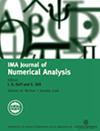四阶非线性波动方程的一种基于局部能量的间断Galerkin方法
IF 2.3
2区 数学
Q1 MATHEMATICS, APPLIED
引用次数: 1
摘要
本文提出了一个基于能量的四阶非线性波动方程的间断Galerkin格式,并将其改写为一个二阶空间导数系统。与局部不连续Galerkin方法相比,该方法使用的辅助变量较少,计算效率较高。我们证明了该方案的几个性质。例如,我们证明了该方案是无条件稳定的,并且它在不施加惩罚项的情况下,在解和辅助变量的$L^2$范数中实现了最优收敛。稳定性和收敛性分析证明的一个关键部分是对涉及位移变量时间导数的辅助方程的检验函数的特殊选择,这导致了未知量时间演化的线性系统。然后,我们可以在不连续伽辽金方法中使用标准数学技术来获得稳定性和最佳误差估计。我们还通过选择简单的和网格无关的单元间通量来获得该方案的能量耗散和/或守恒。给出了几个数值实验来说明和支持我们的理论结果。本文章由计算机程序翻译,如有差异,请以英文原文为准。
A local energy-based discontinuous Galerkin method for fourth-order semilinear wave equations
This paper proposes an energy-based discontinuous Galerkin scheme for fourth-order semilinear wave equations, which we rewrite as a system of second-order spatial derivatives. Compared to the local discontinuous Galerkin methods, the proposed scheme uses fewer auxiliary variables and is more computationally efficient. We prove several properties of the scheme. For example, we show that the scheme is unconditionally stable and that it achieves optimal convergence in $L^2$ norm for both the solution and the auxiliary variables without imposing penalty terms. A key part of the proof of the stability and convergence analysis is the special choice of the test function for the auxiliary equation involving the time derivative of the displacement variable, which leads to a linear system for the time evolution of the unknowns. Then we can use standard mathematical techniques in discontinuous Galerkin methods to obtain stability and optimal error estimates. We also obtain energy dissipation and/or conservation of the scheme by choosing simple and mesh-independent interelement fluxes. Several numerical experiments are presented to illustrate and support our theoretical results.
求助全文
通过发布文献求助,成功后即可免费获取论文全文。
去求助
来源期刊
CiteScore
5.30
自引率
4.80%
发文量
79
审稿时长
6-12 weeks
期刊介绍:
The IMA Journal of Numerical Analysis (IMAJNA) publishes original contributions to all fields of numerical analysis; articles will be accepted which treat the theory, development or use of practical algorithms and interactions between these aspects. Occasional survey articles are also published.

 求助内容:
求助内容: 应助结果提醒方式:
应助结果提醒方式:


